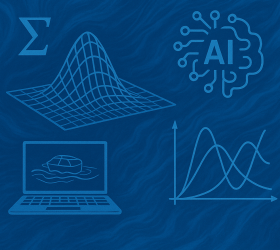Some of my main research lines are related to:
Water resource cleaning
This research initiative is dual-focused, combining theoretical development and practical application in the domain of environmental pollution and water treatment. The primary objectives include the development of robust mathematical models with the capability to predict and detect sources of pollutants while simultaneously optimizing the cleaning process of contaminated water. These models are designed to encompass various environmental contexts, providing a versatile tool for addressing pollution-related challenges. Additionally, the research aims to apply the developed methodology for real-time forecasting and analysis, demonstrating the practical efficacy and versatility of the proposed models in addressing environmental concerns. The keywords guiding this research span wastewater treatment, partial differential equations, bioreactors, mathematical models, oil spill simulation, and optimization methods, reflecting the interdisciplinary nature of this comprehensive research endeavor.
URL: https://www.ucm.es/momat/oil-spills
Epidemiological modelling of human diseases
This research initiative is driven by multifaceted goals aimed at advancing our understanding and management of human diseases. Firstly, the objective is to propose sophisticated mathematical models that comprehensively study the spread patterns of these diseases, identify relevant risk factors, and devise effective control strategies. The subsequent step involves a rigorous validation process, incorporating real epidemic data to ensure the accuracy and practical applicability of the proposed models. Additionally, the research aims to contribute to the scientific community and competent authorities by deploying and disseminating software tools that facilitate the widespread adoption of these models. The keywords guiding this research span human virus diseases, including SARS-CoV-2, COVID-19, and Ebola Hemorrhagic Fever. The chosen mathematical models employ ordinary differential equations, forming the foundation for robust epidemiological modeling. This interdisciplinary approach seeks to provide valuable insights and practical tools for comprehensively understanding and managing infectious diseases on a global scale.
URL: https://www.ucm.es/momat/epidemics
Epidemiological modelling of livestock diseases
This research endeavor is dedicated to advancing our understanding and management of livestock diseases through a multifaceted approach. The primary focus is on proposing mathematical models with a threefold objective: studying the spread patterns of diseases such as Bluetongue, Classical Swine Fever, and Foot and Mouth Disease; estimating the economic impact of outbreaks; and analyzing and improving the efficiency of control measures. The robustness and practical applicability of these models are ensured through rigorous validation using data from real epidemics. Additionally, the research aims to contribute to the scientific community and competent authorities by deploying and disseminating software tools. These tools, grounded in the employed mathematical models and utilizing methodologies like Monte Carlo Simulation, facilitate widespread adoption and practical implementation. This interdisciplinary initiative integrates epidemiological modeling, livestock economics, and simulation techniques to provide comprehensive insights and practical solutions for managing livestock diseases.
URL: https://www.ucm.es/momat/epidemics
Global optimization methods for industrial problems:
This research aims to achieve a set of interconnected goals. Firstly, it seeks to pioneer the development of global optimization methods tailored to address problems featuring computationally intensive cost functions. The second goal involves rigorous validation of these methods through their application to benchmark cases, ensuring robustness and efficacy. Finally, the research endeavors to leverage these advanced optimization methods to solve intricate industrial problems, with a particular emphasis on practical applications in diverse fields, including industrial design, credit risk management, and shape optimization. The overarching keywords guiding this work encompass industrial design, genetic algorithms, metaheuristic approaches, global optimization, credit risk management, and shape optimization.
Modelling and optimization with Comsol Multiphysics. Application to Industrial design problems.
This research project revolves around two core objectives. Firstly, it aims to create educational materials dedicated to Comsol Multiphysics, emphasizing its application in solving industrial design problems. These pedagogical resources intend to facilitate a comprehensive understanding of the software’s capabilities for addressing challenges in industrial design. Secondly, the research endeavors to exemplify the practical efficiency of the proposed methodologies by applying them to real industrial design problems. Through these practical illustrations, the project aims to underscore the tangible benefits and effectiveness of the developed approaches. The keywords guiding this research encompass industrial design, COMSOL Multiphysics, mathematical models, and global optimization.
Modelling and design of microfluidic devices
This research endeavors to make significant contributions to the field of microfluidic devices through a multi-faceted approach. Firstly, the initiative involves proposing intricate mathematical models tailored to provide precise estimations of the performances exhibited by various microfluidic devices. Subsequently, optimization problems are formulated, contingent on specific design parameters, with the overarching objective of refining and improving the performances of these microfluidic devices. The research then employs global optimization approaches to systematically address and solve these identified optimization problems, ensuring a methodical and efficient optimization process. Finally, the results obtained from these optimization endeavors are subjected to rigorous validation through a dual verification process, encompassing both numerical simulations and experimental validations. This comprehensive validation strategy serves to affirm the reliability and practical applicability of the proposed optimizations. The keywords guiding this research encapsulate industrial design, mathematical models, microfluidic engineering, global optimization, and sensitivity and uncertainty analysis, reflecting the diverse and interdisciplinary nature of this scientific exploration.


